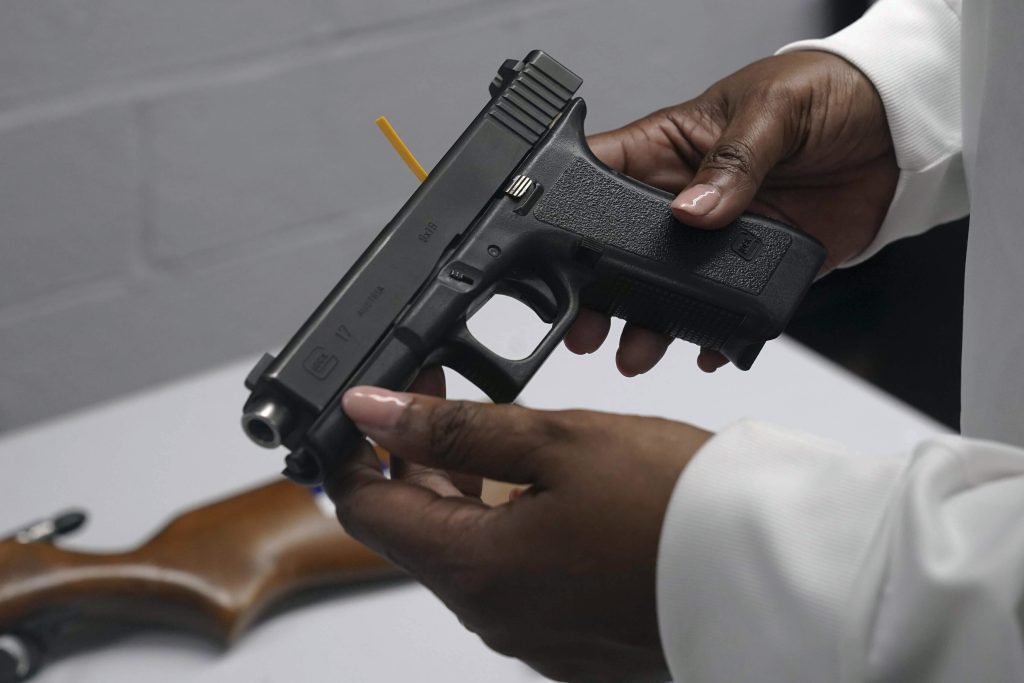Supreme Court expands gun rights, striking New York limits

FILE - A handgun from a collection of illegal guns is reviewed during a gun buyback event in Brooklyn, N.Y., May 22, 2021. The Supreme Court, Thursday, June 23, 2022, struck down a restrictive New York gun law in a major ruling for gun rights. (AP Photo/Bebeto Matthews, FIle)
WASHINGTON (AP) — In a major expansion of gun rights, the Supreme Court said Thursday that Americans have a right to carry firearms in public.
The justices’ 6-3 decision follows a series of recent mass shootings and is expected to ultimately allow more people to legally carry guns on the streets of the nation’s largest cities — including New York, Los Angeles and Boston — and elsewhere. About a quarter of the U.S. population live in states expected to be affected by the ruling, the high court’s first major gun decision in more than a decade.
The ruling comes as Congress is working toward passage of gun legislation following mass shootings in Texas,New York and California.
Justice Clarence Thomas wrote for the majority that the Constitution protects “an individual’s right to carry a handgun for self-defense outside the home.”
In their decision, the justices struck down a New York law requiring people to demonstrate a particular need for carrying a gun in order to get a license to carry one in public. The justices said that requirement violates the Second Amendment right to “keep and bear arms.”
California, Hawaii, Maryland, Massachusetts, New Jersey and Rhode Island all have similar laws. The Biden administration had urged the justices to uphold New York’s law.
New York Gov. Kathy Hochul said the decision comes at a particularly painful time, when New York is still mourning the deaths of 10 people in a mass shooting at a supermarket in Buffalo. “This decision isn’t just reckless. It’s reprehensible. It’s not what New Yorkers want,” she said.
In a dissent joined by his liberal colleagues, Justice Stephen Breyer focused on the toll taken by gun violence. “Since the start of this year alone (2022), there have already been 277 reported mass shootings—an average of more than one per day,“ Breyer wrote.
Backers of New York’s law had argued that striking it down would lead to more guns on the streets and higher rates of violent crime. Gun violence, which was already on the rise during the coronavirus pandemic has spiked anew.
In most of the country gun owners have little difficulty legally carrying their weapons in public. But that had been harder to do in New York and the handful of states with similar laws. New York’s law, which has been in place since 1913, says that to carry a concealed handgun in public, a person applying for a license has to show “proper cause,” a specific need to carry the weapon.
The state issues unrestricted licenses where a person can carry their gun anywhere and restricted licenses that allow a person to carry the weapon but just for specific purposes such as hunting and target shooting or to and from their place of business.
The Supreme Court last issued a major gun decision in 2010. In that decision and a ruling from 2008 the justices established a nationwide right to keep a gun at home for self-defense. The question for the court this time was about carrying one outside the home.
The challenge to the New York law was brought by the New York State Rifle & Pistol Association, which describes itself as the nation’s oldest firearms advocacy organization, and two men seeking an unrestricted ability to carry guns outside their homes.
The court’s decision is somewhat out of step with public opinion. About half of voters in the 2020 presidential election said gun laws in the U.S. should be made more strict, according to AP VoteCast, an expansive survey of the electorate. An additional third said laws should be kept as they are, while only about 1 in 10 said gun laws should be less strict.
About 8 in 10 Democratic voters said gun laws should be made more strict, VoteCast showed. Among Republican voters, roughly half said laws should be kept as they are, while the remaining half closely divided between more and less strict.








